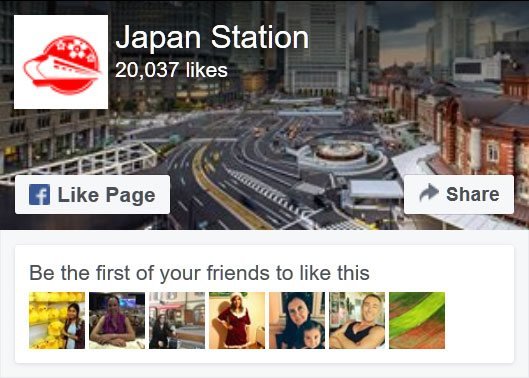The Okhotsk is a limited express service operated by JR Hokkaido that runs between Sapporo and Abashiri. The service is named after the northern Sea of Okhotsk that lies between Japan and Russia.
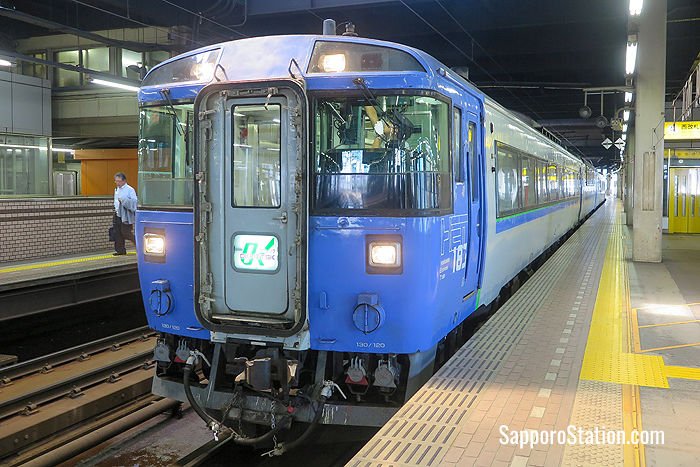
The Okhotsk at Sapporo Station
There are two daily services to Abashiri, and two return services to Sapporo. Travel times vary but the full journey time is around 5 hours and 30 minutes. This service is completely covered by the Japan Rail Pass. At Sapporo Station this service departs from Platforms 7 and 8.
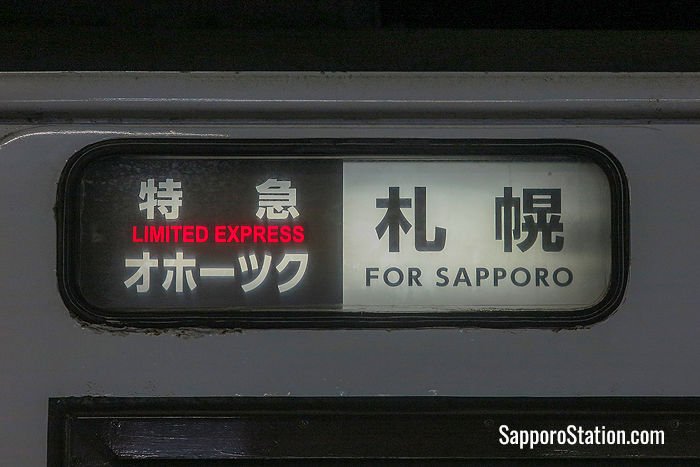
A carriage banner on the Okhotsk
Key Destinations
There are 17 stations on the route of the Okhotsk which runs via the Hakodate Main Line, Soya Main Line, and Sekihoku Main Line.
Sapporo – Iwamizawa – Bibai – Sunagawa – Takikawa – Fukagawa – Asahikawa – Kamikawa – Shirataki – Maruseppu – Engaru – Ikutahara – Rubeshibe – Kitami – Bihoro – Memanbetsu – Abashiri
- Okhotsk #1 does not stop at Marussepu.
- Okhotsk #2 does not stop at Sunagawa and Bibai.
- Okhotsk #4 does not stop at Shirataki.
The key destinations are listed below with non-reserved fares and example journey times given from Sapporo Station.
Sapporo Station
Sapporo is the biggest city in Hokkaido and its capital. This city has a rich array of shopping, dining, and entertainment facilities as well as historic buildings and museums. Sapporo’s attractions include the 19th century Sapporo Clock Tower (also called Sapporo Tokeidai), the Sapporo Beer Museum and Garden, the Susukino entertainment district, the ropeway that leads to the summit of Mount Moiwa, and Hokkaido University Museum which has exhibits on science, natural history, and the history of the university.
Transfers can be made here to local services on the Hakodate Main Line, Chitose Line and Gakuen-Toshi Line. This station also has limited express services for Hakodate, Abashiri, Wakkanai, Kushiro, Obihiro and Muroran, and rapid services for Niseko, Otaru and New Chitose Airport.
Iwamizawa Station
The city of Iwamizawa has a number of tourist attractions.
Hokkaido Greenland amusement park has 46 rides including Hokkaido’s longest roller-coaster and its tallest Ferris wheel.
Hosui Winery is open for tours and wine tasting from April to November.
Iwamizawa Park has a rose garden and a local history and science museum which includes a planetarium.
Log Hotel Maple Lodge is a resort with natural hot spring spa facilities that can be enjoyed by day trippers as well as overnight guests.
Train fare: 1,600 yen
Train time: 27 minutes
Bibai Station
Bibai’s main attractions are the Arte Piazza sculpture museum, and Bibai Snow Land.
Arte Piazza is an open-air sculpture park which features 40 marble and bronze sculptures by the contemporary artist Kan Yasuda who was born in Bibai. There is a café in the park, a gallery, and there are also sculpting classes on the first weekend of the month. Arte Piazza is free to enter is a 20 minute bus ride or 10 minute taxi ride from Bibai Station.
Bibai Snow Land is a winter activity park which has range of activities including snow shoeing, snow tubing, snowmobile touring, snow rafting, snow golf, and snow soccer! There is also a restaurant on site where you can enjoy delicious nabe-style seafood hotpots. Bibai Snow Land is a 15 minute taxi ride from Bibai Station but there is also a free shuttle service which can be booked in advance.
Train fare: 2,440 yen
Train time: 39 minutes
Takikawa Station
Takikawa’s main attractions are Takikawa Sky Park where you can experience flying in a glider the natural hot spring facilities at Takikawa Fureai-no-sato. Many people also come to Takikawa for the Lantern Festival in February and for the Nanohana Festival in May to view the bright yellow fields of canola flowers (called nanohana in Japanese).
Transfer here to the Nemuro Main Line.
Train fare: 3,040 yen
Train time: 58 minutes
Fukagawa Station
Transfer here to the Rumoi Main Line.
Train fare: 4,250 yen
Train time: 1 hour and 14 minutes
Asahikawa Station
Asahikawa is Hokkaido’s second largest city and is a good base for trips into Daisetsuzan National Park or to the lavender fields of Furano. The most popular attraction inside Asahikawa is its zoo, but there are number of other interesting tourist spots that can all be accessed easily from the station area.
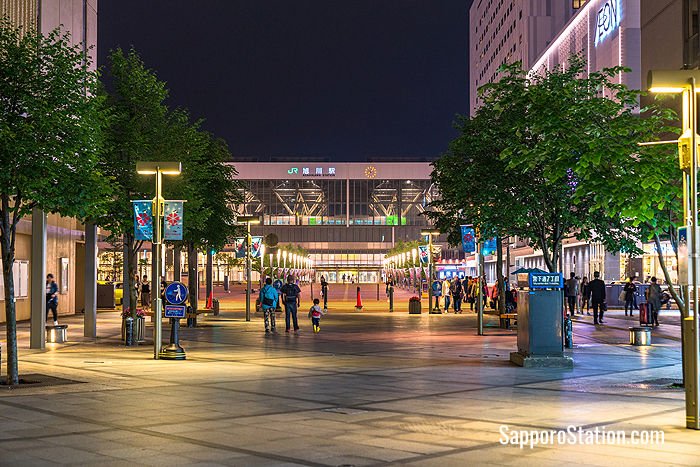
Asahikawa Station
Asahiyama Zoo has animals from several continents including Asian tigers, South American penguins, African hippos, and polar bears. The zoo is cleverly constructed to allow visitors safe but close-up views of the animals in habitats that resemble their natural environment. Buses from Asahikawa Station take 40 minutes to reach the zoo while a taxi ride will take about 30 minutes.
Otokoyama Sake Brewery Museum displays traditional sake making methods and Ukiyo-e woodblock prints showing the sake making process. There is also a sake sampling corner, and a shop where you can buy your favorites. Entrance to the museum is free and it is a 20 minute taxi ride from Asahikawa Station.
Kita-no-Arashiyama is a craft village with several workshops and galleries featuring pottery, woodwork, glass, and dyed materials. Visitors can take part in pottery and glass making experiences and also take part in the traditional tea ceremony. To get to the village from the station take the number 3 or 33 bus for 20 minutes.
Asahikawa Ramen Village is a collection of eight ramen noodle restaurants where visitors can try a variety of ramen types by ordering small bowls at each shop. To reach the Ramen Village take the Sekihoku Line from Asahikawa Station for 10 minutes and get off at Minami-Nagayama Station. The Ramen Village is a 7 minute walk from the station.
Kamui Ski Links and the Asahidake Ski Resort are popular skiing locations near Asahikawa. Close by Asahidake Ski Resort is the hot spring resort of Asahidake Onsen. The onsen can be reached from Asahikawa Station by car in 70 minutes or by bus in 90 minutes.
Transfer at Asahikawa Station to the Soya Main Line, Sekihoku Main Line, and Furano Line.
Train fare: 4,690 yen
Train time: 1 hour and 36 minutes
Kamikawa Station
Passengers who wish to visit the hot spring resort of Sounkyo Onsen should catch a bus from Kamikawa Station. The bus takes 30 minutes to arrive at the mountain valley resort that has 17 hotels set in magnificent scenery with steep cliffs and waterfalls. Choyo Resort Hotel is a popular hotel in this area that has a range of bathing facilities with saunas, excellent dining facilities, and both Western and Japanese style guest rooms. From Sounkyo Onsen visitors can take a gondola on the Kurodake Ropeway to an observation deck on Mount Kurodake. This area is particularly popular for its fall colors in the autumn season.
Train fare: 6,270 yen
Train time: 2 hours and 20 minutes
Rubeshibe Station
Passengers who wish to visit the Onneyu Onsen hot spring resort should take a 20 minute bus from Rubeshibe Station. Oehonke is a luxurious hot spring hotel in this area which has multiple indoor and outdoor baths with gorgeous views over the mountains. Onneyu Onsen is close to two local attractions the Northern Daichi Aquarium which exhibits freshwater fish from around the world, and the Kitakitsune Northern Fox Farm where you can view a variety of wild fox species.
Train fare: 8,690 yen
Train time: 4 hours and 13 minutes
Bihoro Station
Bihoro Pass is a famous scenic spot which is about 30 minutes by car or bus from Bihoro Station. From the pass visitors can enjoy the spectacular view over Lake Kussharo. Also in Bihoro is Bihoro Aviation Park is an open air museum where you can view a variety of vintage helicopters and planes. The park is about 8 minutes by taxi from Bihoro Station.
Train fare: 9,790 yen
Train time: 4 hours and 55 minutes
Abashiri Station
Abashiri is a popular destination in the winter when tourists come to see the drift ice (which is called ryuhyo in Japanese) on the Sea of Okhotsk. February is the best time to see the drift ice and there are hourly cruises from Abashiri’s harbor to view it.
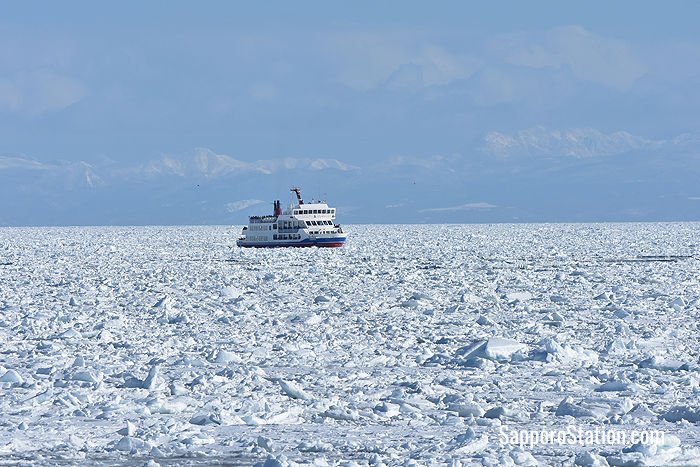
Abashiri drift ice sightseeing icebreaker ship Aurora
JR Hokkaido also operates a seasonal sightseeing train called the Ryuhyo Monogatari which runs along the seacoast so that passengers can view the drift ice. The train runs two return trips a day throughout the month of February between Abashiri Station and Shiretoko-Shari Station on the Senmo Main Line. All seats are non-reserved and the fare is 970 yen. In addition to these activities Abashiri has some interesting museums.
The Okhotsk Ryuhyo Museum is a science museum that has actual drift ice that you can see and touch as well as an observation deck on the roof.
The Abashiri Prison Museum is an outdoor museum where you can view old prison buildings of the 19th and early 20th century. During the Meiji era (1868 – 1912) political prisoners were sent here and forced to do hard labor building roads to connect the far north of Hokkaido to the south. The museum shows how the prisoners lived and many of the buildings are now nationally designated Important Cultural Properties.
Hokkaido Museum of Northern Peoples has exhibits on Hokkaido’s Ainu indigenous culture together with other northern peoples in areas such as northern Europe and Greenland.
Abashiri is also a good base for trips to the Shiretoko Peninsula, either by rail to Shiretoko-Shari Station or by rental car. The peninsula is a designated National Park and famous for its unspoilt natural scenery.
Transfer at Abashiri Station to the Senmo Main Line.
Train fare: 10,010 yen
Train time: 5 hours and 22 minutes
Timetables
The current timetables are given below with arrival times for the major destinations
| Service | Sapporo | Asahikawa | Abashiri |
| Okhotsk #1 | 6.56 | 8.32 | 12.18 |
| Okhotsk #3 | 17.30 | 19.05 | 23.00 |
| Service | Abashiri | Asahikawa | Sapporo |
| Okhotsk #2 | 5.56 | 9.44 | 11.18 |
| Okhotsk #4 | 17.25 | 21.14 | 22.53 |
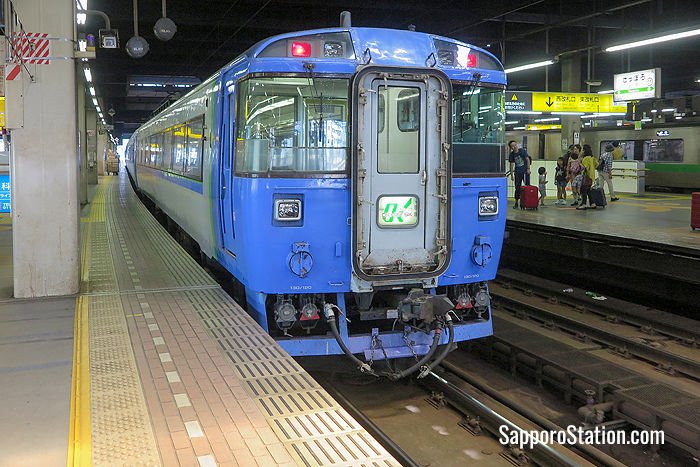
A Kiha #183 series train operating as the Okhotsk
About the Okhotsk
The Okhotsk uses a Kiha #183 series train with four cars. Car 1 has reserved seats, Car 2 is a Green Car with 1st class seats, Car 3 is divided equally between reserved and non-reserved seats, and Car 4 has only unreserved seating. Power outlets are available in all cars and there is normally luggage space in Cars 1 and 3. All cars are non-smoking.
Useful Information
A timetable and route finder, and a downloadable route map can be found on the official JR Hokkaido English language website.
Article by Michael Lambe. Photos by Michael Lambe, matya1234/pixta (3), marumi/pixta (4). All rights reserved.
